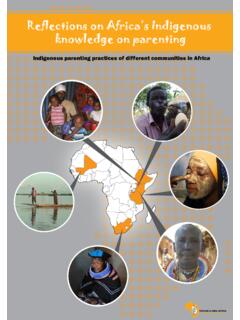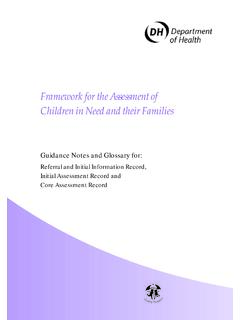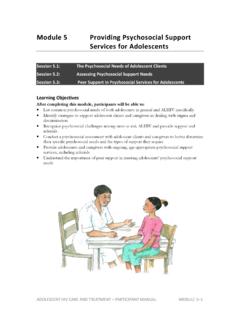Transcription of CHALLENGES AFFECTING ORPHANS AND VULNERABLE …
1 International Journal of Sociology , Issue 1 pp 18-36, 2018 17 CHALLENGES AFFECTING ORPHANS AND VULNERABLE CHILDREN (OVCS) IN EMBU COUNTY Dorcas Nthenya Mutiso and Dr. Pius Mutuku Mutie International Journal of Sociology , Issue 1 pp 18-36, 2018 18 CHALLENGES AFFECTING ORPHANS AND VULNERABLE CHILDREN (OVCS) IN EMBU COUNTY 1*Dorcas Nthenya Mutiso 1 Post Graduate Student: University of Nairobi *Corresponding Author s Email: 2Dr.
2 Pius Mutuku Mutie Lecturer: University of Nairobi Abstract Purpose: To assess the CHALLENGES AFFECTING ORPHANS and VULNERABLE children (OVCS) in Embu County. Methods: This study adopted a descriptive research design. The target population was the ORPHANS and VULNERABLE children support programs in Embu County. Stratified sampling was used to select 10% of ORPHANS and VULNERABLE children in each location. Data was collected through household interviews, key informant interviews, observation, desk review, case studies and focus group discussions. Descriptive statistics was used to summarize the data, to enable the researcher to meaningfully describe a distribution of scores or measurements using a few statistics. Results: The findings of the study indicate that the situation of ORPHANS and VULNERABLE children is escalating.
3 The community suspects that large numbers of people are infected with HIV/AIDS. This study has shown that the family members are currently taking care of over 90% of OVC is under extreme pressure, and unless governments and international development partners redouble their current efforts to increase the capacity of the families to cope, the quality of lives of foster OVC and all children in VULNERABLE households remain in danger. Unique contribution to theory, practice and policy: It is recommended that the community be involved in raising awareness of the value of life and support education in improving children future. The government should also make policies and programs that target communities where the epidemic has left the largest numbers of ORPHANS , VULNERABLE children and affected families.
4 Key words: Children, ORPHANS , VULNERABLE , CHALLENGES . International Journal of Sociology , Issue 1 pp 18-36, 2018 19 INTRODUCTION Background of the Study In 2003 the UN estimated the total number of ORPHANS to be over 43 million that is of all children in the region. This is an increase of over 1/3 since 1990. According to Spiegel (2004), the highest concentrations of ORPHANS are in countries that have a high HIV prevalence level or recently have been involved in armed conflict. Even though children lose their parents for many different reasons, the issue of HIV/AIDS is hard to avoid when talking about ORPHANS and VULNERABLE children.
5 HIV/AIDS is the leading killer worldwide of people between 15-49 years old. Similarly, orphan hood is the most visible and measurable impact this disease has on children s lives. The numbers of ORPHANS in the world would be declining if it were not for HIV/AIDS (UNICEF, 2004). By 2010 UNICEF estimates the number of children orphaned by AIDS in Sub-Saharan Africa to reach million. The UN states that the worst is yet to come , as young adults now living with HIV eventually develop AIDS and die, they will leave behind large number of ORPHANS (UNICEF, 2008; UNICEF, 2003). The number of ORPHANS generally increases with age, hence older ORPHANS greatly outnumber younger ones (UNICEF, 2004).
6 These children will suffer long before they lose their parents. They may miss out on their education as they may be taken out of school to care for their sick parents. This is especially a problem for girls as they are often the first ones to be given the responsibility of caring for the sick. Studies show that in addition to be deprived of their education, these children often live in households with less food security and have a higher risk of suffer from anxiety and depression (Richter, 2004). Orphaned children may also be forced to relocate and in this process lose their social networks and the community they are familiar with (UNICEF, 2008). There is no doubt that the children orphaned by AIDS and the problems they face needs attention and solutions.
7 However, this focus on children orphaned by AIDS has put the sufferings of ORPHANS of other reasons in the shadow (Foster, 2005), as donor and aid campaigns have often been directed at solely helping children orphaned by AIDS. This study does not make any distinctions between ORPHANS and VULNERABLE children of AIDS and ORPHANS and VULNERABLE children of other reasons. The vast majority of children orphaned in Sub-Saharan Africa are cared for by the extended family system, a coping mechanism that have cared for ORPHANS and VULNERABLE children, aged people and disadvantaged family members for generations. Statement of the problem The extended family system care for most of these children, but there are still many that are left on their own (Ahiadeke, 2003).
8 Like in the rest of Africa, the functioning of the extended family system is changing. It has for generations functioned as a safety-net for ORPHANS and VULNERABLE children, but due to modernization this is changing. Migration to urban areas creates a distance between people and their extended family and people tend to lose their feeling of responsibility towards more distant family members. The growing idea of the nuclear family also contributes to the notion of the family consisting of mainly International Journal of Sociology , Issue 1 pp 18-36, 2018 20 mother, father and children, leaving out the rest.
9 Poverty is also a major reason why ORPHANS are rejected by their extended families. The share number of ORPHANS are becoming too much to handle for poor households. They simply do not have the resources to care for them. The children that have been taken in by their extended families sometimes risk abuse and neglect, but as a result of poverty they also risk being sent out to steal or practice prostitution. The latter is especially a problem for girls. Some children are also denied access to basic education, proper healthcare and nutrition (Ahiadeke, 2003). At community level, various community groups have developed a wide range of responses through their own initiative and also through support by NGOs working in their locality.
10 There are over 12 million ORPHANS in Sub-Saharan Africa, where it is estimated that 9% of all children have lost at least one parent to AIDS. The UN Children s Fund (UNICEF 2008) estimated that the number of OVC in sub-Saharan Africa would climb to more than 16 million ORPHANS and VULNERABLE children by 2011. In Kenya alone, it is estimated that there are 1,100,000 ORPHANS , with a similar number in South Africa, Tanzania, Malawi and Zimbabwe (UNICEF 2008). This is a relatively high number as it comprises almost 10% of all children in Kenya (UNICEF, 2008). The same report also suggested that the heaviest concentrations of both VULNERABLE children and children orphaned by AIDS lie in the age segment 10-14 years old ( for boys and for girls).














